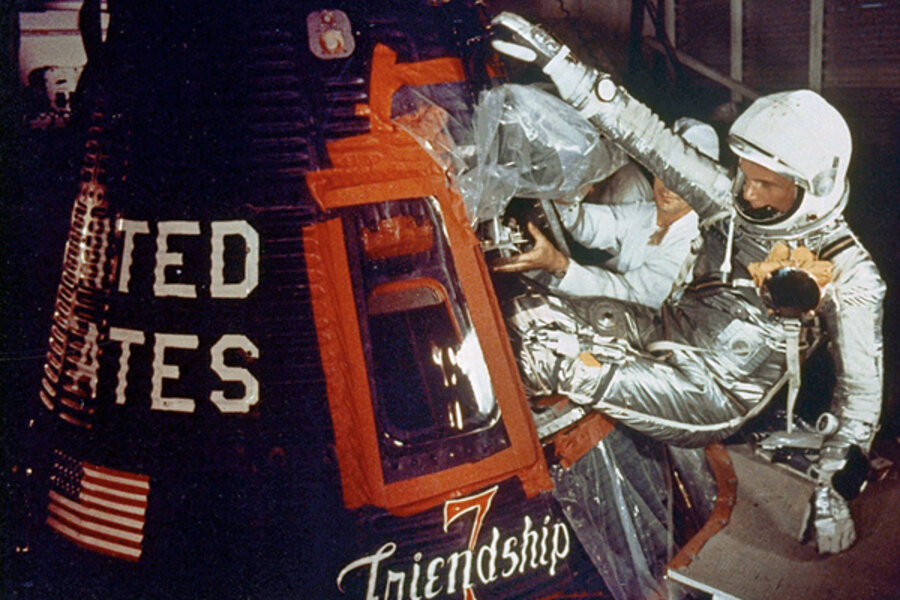John Glenn's first spaceflight was fraught with risks and unknowns
Loading...
When John Glenn launched on the United States' first orbital spaceflight 50 years ago today (Feb. 20), NASA scientists weren't sure where he'd come down — or if he'd even survive the trip.
Before Glenn completed three laps of Earth on Feb. 20, 1962, no American had spent more than 15 minutes in space. So NASA top brass and medical personnel had a laundry list of worries, from where Glenn's spacecraft would touch down to whether or not the astronaut's eyes would function properly in microgravity.
"There were a lot of unknowns in the early days of spaceflight," former astronaut Scott Carpenter, who completed an orbital mission of his own in May 1962, said Friday (Feb. 17) at a NASA event commemorating Glenn's flight. "We were considered guilty of being unable to fly in space and required to prove our innocence, counter to the American custom."
Medical concerns
By the time of Glenn's flight, space-race rival the Soviet Union had already launched two manned orbital missions. Cosmonaut Yuri Gagarin circled the Earth once in April 1961, and his countryman Gherman Titov orbited our planet 17 times in August of that year, staying aloft for more than 24 hours.
Both Gagarin and Titov returned to Earth safely after their flights. But NASA had no experience with human spaceflight beyond the 15-minute suborbital jaunts of Alan Shepard and Gus Grissom in 1961, so agency personnel worried about how Glenn's body would hold up during nearly five hours in space.
Doctors were particularly concerned about how prolonged exposure to microgravity would affect Glenn's vision. [Photos: John Glenn's Space Legacy]
"Some of the ophthamologists were literally concerned at that time that your eyes might change shape and your vision might change enough you couldn't even see the instrument panel enough to make an emergency re-entry if you had to," Glenn said during Friday's festivities.
"They were enough concerned about it, we actually put a little miniaturized eye chart at the top of the instrument panel," he added. "And that's still in Friendship 7, up in the Smithsonian [National Air and Space Museum]."
NASA also worried that spaceflight might cause fluid to move around randomly in Glenn's inner ear, perhaps resulting in nausea and vertigo. And doctors weren't even sure if the astronaut would be able to swallow properly in microgravity, Glenn said.
Concern and curiosity about digestive functions persisted through Carpenter's flight, three months later. Doctors weren't convinced astronauts would be able to metabolize food on orbit, so they had Carpenter perform a little experiment. [Biggest Revelations of the Space Age]
"I was given some radioactive food — pap — in a toothpaste tube," Carpenter said. "And I was told to eat that on the first orbit."
History has shown, of course, that the human body can perform basic functions in space. Astronauts routinely live on the International Space Station for six-month stints, though they must exercise assiduously to minimize the effects of microgravity, which include muscle wasting and decreased bone density.
A dicey re-entry
Glenn's flight plan called for Friendship 7 to splash down in the Atlantic Ocean several hundred miles southeast of Florida. But NASA wasn't entirely sure that would work out, so Glenn prepared for the possibility of landing among "primitive" aboriginal peoples in backcountry Australia, Papua New Guinea or southern Africa.
"You land, and the side blows off, and out steps this thing in a silver suit. You're going to be either like the god-king or dead pretty quick," Glenn said. "So I wanted a message for these people."
So linguists at the Library of Congress translated a basic message of peace and friendship for Glenn, arming him with a few phrases in various aboriginal languages should the need arise.
Friendship 7 eventually did re-enter roughly where it was supposed to, dropping into the Atlantic just 40 miles (67 kilometers) short of the planned landing zone. But the capsule's return to Earth was a bumpy and somewhat harrowing one.
As Glenn prepared to re-enter the atmosphere, mission managers told him that Friendship 7's protective heat shield may have come loose. This was bad news; if the heat shield came off, the capsule would almost certainly burn up.
Strapped to the outside of Friendship 7 was a package of small retro-rockets, which were designed to help slow the capsule's re-entry. Glenn was told not to jettison the rockets after firing them, in the hopes that the straps would help hold the heat shield on.
During re-entry, "there were flaming chunks of the retro-pack burning off and coming back by the window," Glenn said. "I didn't know for sure whether it was the retro-pack or the heat shield, but there wasn't anything I could do about it either way, except just keep trying to work and keep the spacecraft on its actual best attitude coming back in."
Though everything worked out in the end, Glenn's success was far from assured or pre-ordained. In fact, launching him into orbit was something of a game of Russian roulette, experts say. The odds of success were comparable, anyway.
"His odds of not surviving this was about one in six," former astronaut Steve Lindsey, who flew with Glenn on the space shuttle Discovery's STS-95 mission in 1998, said in a recent NASA video. "So it was an extremely high-risk, unknown effort that they were going into, having never done it before."
You can follow SPACE.com senior writer Mike Wall on Twitter: @michaeldwall. Follow SPACE.com for the latest in space science and exploration news on Twitter @Spacedotcomand on Facebook.







